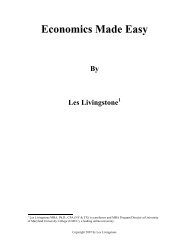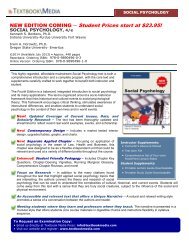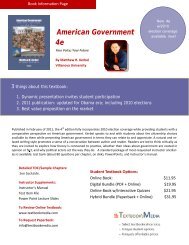Book Information / Sample Chapter(s) (PDF) - Textbook Media
Book Information / Sample Chapter(s) (PDF) - Textbook Media
Book Information / Sample Chapter(s) (PDF) - Textbook Media
You also want an ePaper? Increase the reach of your titles
YUMPU automatically turns print PDFs into web optimized ePapers that Google loves.
74 <strong>Chapter</strong> 4 Demand and Supply<br />
One common mistake in applying the demand and supply framework is to confuse the<br />
shift of a demand or a supply curve with the movement along a demand or supply curve.<br />
As an example, consider a problem that asks whether a drought will increase or decrease<br />
the equilibrium quantity and equilibrium price of wheat. Lee, a student in an introductory<br />
economics class, might reason:<br />
“Well, it’s clear that a drought reduces supply, so I’ll shift back the supply curve, as in<br />
the shift from the original supply curve S 0<br />
to S 1<br />
shown on the diagram (call this Shift 1). So<br />
the equilibrium moves from E 0<br />
to E 1<br />
, the equilibrium quantity is lower and the equilibrium<br />
price is higher. Then, a higher price makes farmers more likely to supply the good, so the<br />
supply curve shifts right, as shown by the shift from S 1<br />
to S 2<br />
on the diagram (shown as<br />
Shift 2), so that the equilibrium now moves from E 1<br />
to E 2<br />
. But the higher price also reduces<br />
demand and so causes demand to shift back, like the shift from the original demand curve<br />
D 0<br />
to D 1<br />
on the diagram (labeled Shift 3), and the equilibrium moves<br />
from E 2<br />
to E 3<br />
.”<br />
At about this point, Lee suspects that this answer is headed<br />
down the wrong path. Think about what might be wrong with Lee’s<br />
logic, and then read the answer that follows.<br />
Answer: Lee’s first step is correct: that is, a drought shifts<br />
back the supply curve of wheat and leads to a prediction of a lower<br />
equilibrium quantity and a higher equilibrium price. The rest of<br />
Lee’s argument is wrong, because it mixes up shifts in supply with<br />
quantity supplied, and shifts in demand with quantity demanded. A<br />
higher or lower price never shifts the supply curve, as suggested by<br />
the shift in supply from S 1<br />
to S 2<br />
. Instead, a price change leads to a<br />
movement along a given supply curve. Similarly, a higher or lower<br />
price never shifts a demand curve, as suggested in the shift from D 0<br />
to D 1<br />
. Instead, a price change leads to a movement along a given<br />
demand curve. Remember, a change in the price of a good never<br />
causes the demand or supply curve for that good to shift.<br />
Price<br />
Clearing It Up<br />
Shifts of Demand<br />
or Supply versus<br />
Movements along a<br />
Demand or Supply<br />
Curve<br />
S 2<br />
S 0<br />
E 1<br />
Shift 1<br />
E 2<br />
Shift 2<br />
E 0<br />
Shift 3<br />
S 1<br />
D 0<br />
Quantity<br />
D 1<br />
In the four-step analysis of how economic events affect equilibrium price and<br />
quantity, the movement from the old to the new equilibrium seems immediate. But<br />
as a practical matter, prices and quantities often do not zoom straight to equilibrium.<br />
More realistically, when an economic event causes demand or supply to shift, prices<br />
and quantities set off in the general direction of equilibrium. Indeed, even as they are<br />
moving toward one new equilibrium, prices are often then pushed by another change<br />
in demand or supply toward another equilibrium.<br />
Price Ceilings and Price Floors in Markets for<br />
Goods and Services<br />
Controversy often surrounds the prices and quantities that are established by demand<br />
and supply. After all, every time you buy a gallon of gasoline, pay the rent for your<br />
apartment, or pay the interest charges on your credit card, it’s natural to wish that the<br />
price had been at least a little lower. Every time a restaurant sells a meal, a department<br />
store sells a sweater, or a farmer sells a bushel of wheat, it’s natural for the profit-seeking<br />
seller to wish that the price had been higher. In some cases, discontent over prices turns<br />
into public pressure on politicians, who may then pass legislation to prevent a certain<br />
price from climbing “too high” or falling “too low.” The demand and supply model













